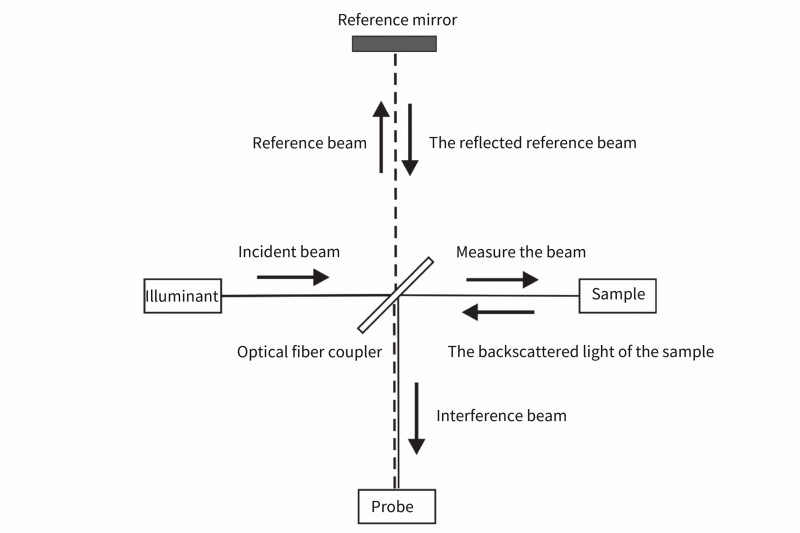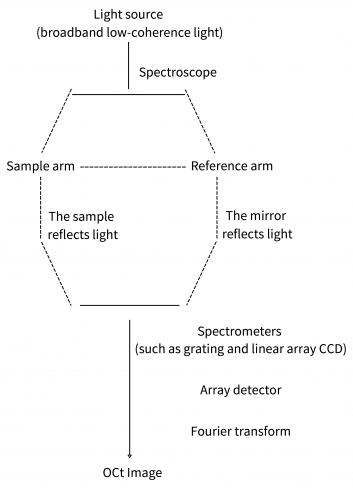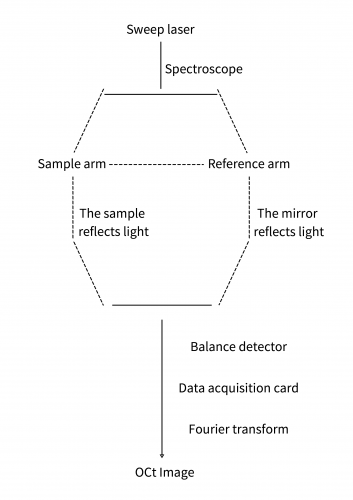OCT技术
OCT technology
OCT technology
Optical Coherence Tomography (OCT) is a non-invasive, high-resolution imaging technology that is widely used in medical, industrial and other fields.
Its core principle is based on low coherence interferometry, which combines the interference properties of light waves to reconstruct a two-dimensional or three-dimensional image of the internal structure of a sample.



Basic principle
OCT takes advantage of the low-coherence interference principle of light. It is done by dividing the light emitted by a broadband light source into two beams, shining one beam onto the object under test (sample light), and backscattering (backscattering) occurs after the light enters the object under test. The other beam serves as a reference light, which is reflected to a fixed reference mirror and returned. The two beams of light rejoin at the beam splitter, producing an interference signal. Only when the optical path difference between the two arms is within the coherence length of the light source will an effective interference signal be formed. By measuring the variation of the interference signal with the optical path difference, the information of different depths inside the sample can be obtained, and then the two-dimensional or three-dimensional structure image of the sample can be reconstructed.

Concrete implementation mode

Illuminant
Broadband light sources such as ultra-radiant light emitting diodes (SLED) or broadband lasers are usually used, which emit light with a wide spectral range to achieve high-resolution depth measurements.

Probe
High speed photodetectors are used to detect interference signals. The detector converts the optical signal into an electrical signal and records information such as the intensity and phase of the interference signal.

Optical interferometer
Michelson interferometer structure is generally used, which can divide the incident light into sample light and reference light, and make the two beams interfere when returning. By precisely controlling the length of the reference optical arm, the optical path difference can be adjusted to scan sample information at different depths.

Signal processing and image reconstruction
A large number of interference signals collected by the detector are processed and analyzed by computer. By Fourier transform and other algorithms, the interference signal is transformed from time domain to frequency domain, and the reflectance information of the sample at different depths is obtained. According to this information, a suitable image reconstruction algorithm, such as raster scanning or line scanning, is used to construct a two-dimensional or three-dimensional image of the sample.
SD-OCT and SS-OCT
SD-OCT
Spectral Domain OCT (SD-OCT) enables frequency-domain analysis through spectrometers and array detectors, and is suitable for static or medium-speed high-resolution imaging, such as retinal imaging in ophthalmology.

SS-OCT
Swept-frequency OCT (SS-OCT) uses swept-frequency light sources and single-point detectors to acquire deep tissue information at ultra-high speeds, suitable for dynamic scenarios (such as cardiovascular blood flow) and industrial online detection.

OCT key parameters
Axial resolution
Definition: Resolution along the direction of light propagation, usually 1 to 15 microns. Determining factor: the bandwidth of the light source (the wider the bandwidth, the higher the resolution).

- Δz :Axial resolution (in meters, usually expressed in microns);
- λ0:Central wavelength of light source (unit: m);
- Δλ:Spectral bandwidth of light source (unit: m)
Lateral resolution
Definition: Resolution perpendicular to the direction of light propagation, usually 5 to 20 microns. Determining factors: Numerical aperture (NA) and focused spot size of the objective lens, similar to traditional microscopes.

- Δx :Lateral resolution (in meters, usually expressed in microns);
- λ0:Central wavelength of light source (unit: m);
- NA:Numerical aperture of the objective,Defined as NA=n sinθ ;
- n:The refractive index of the medium between the objective lens and the sample (n=1 in air, n≈1.33−1.4 in tissue or water);
- θ:Half Angle of the aperture of the objective(half Angle of focus cone)。
Light source parameter
Center wavelength:
- 800~900 nm: Suitable for shallow high-resolution imaging (such as retina, high-resolution surface detection, transparent/translucent materials, etc.).
- 1300-1550 nm: Suitable for deep tissues (such as skin, blood vessels, composite materials, silicon-based materials, thick layer materials, high-scattering materials, etc.).
Bandwidth: It determines the axial resolution. A superlight-emitting diode (SLD) or a supercontinuous light source can achieve a broadband spectrum.
Imaging depth
Definition: The maximum depth at which light penetrates within a tissue, usually 1 to 3 mm (depending on the tissue type).
Influencing factors: Light source wavelength (for example, 1300 nm penetrates deeper but scatters more strongly than 800 nm), tissue scattering characteristics.
Scanning speed
Definition: The number of A-scans (axial scans) obtained per second.
Frequency-domain OCT can reach tens of thousands to hundreds of thousands of times per second and is suitable for imaging dynamic tissues such as the heart and blood flow.
